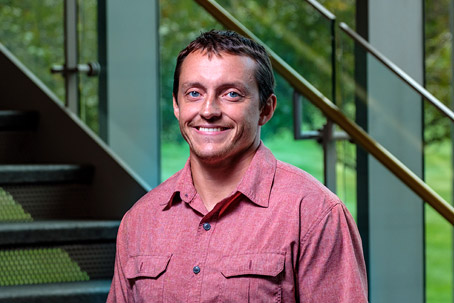Computational Neuroethology Lab at IU Bloomington
Using theory-driven computational modeling, we investigate how adaptive behavior arises from the interaction of living cells, bodies, and environments. Our questions necessarily span fields from philosophy to physics to sociology, and scales from molecules to brains to groups of individuals. Mathematical tools from dynamical systems theory and information theory are commonly useful for analyzing our models in depth. Further, we use evolutionary algorithms to generate artificial agents which are analyzable from a naturalistic perspective. Central to these research programs is the idea that, in order to make sense of life, behavior, and cognition as we know it, we must work to establish foundational principles.
Broad Research Programs
Neuromechanical basis of behaviors in C. elegans: Spatial orientation, locomotion
Fringilla nisl. Donec accumsan interdum nisi, quis tincidunt felis sagittis eget. tempus euismod. Vestibulum ante ipsum primis in faucibus vestibulum. Blandit adipiscing eu felis iaculis volutpat ac adipiscing accumsan eu faucibus. Integer ac pellentesque praesent tincidunt felis sagittis eget. tempus euismod. Vestibulum ante ipsum primis in faucibus vestibulum. Blandit adipiscing eu felis iaculis volutpat ac adipiscing accumsan eu faucibus. Integer ac pellentesque praesent. Donec accumsan interdum nisi, quis tincidunt felis sagittis eget. tempus euismod.
Minimal models of cognition and social interaction
Fringilla nisl. Donec accumsan interdum nisi, quis tincidunt felis sagittis eget. tempus euismod. Vestibulum ante ipsum primis in faucibus vestibulum. Blandit adipiscing eu felis iaculis volutpat ac adipiscing accumsan eu faucibus. Integer ac pellentesque praesent tincidunt felis sagittis eget. tempus euismod. Vestibulum ante ipsum primis in faucibus vestibulum. Blandit adipiscing eu felis iaculis volutpat ac adipiscing accumsan eu faucibus. Integer ac pellentesque praesent. Donec accumsan interdum nisi, quis tincidunt felis sagittis eget. tempus euismod.
Individual differences, adaptability, and degeneracy in fitness landscapes
 Fringilla nisl. Donec accumsan interdum nisi, quis tincidunt felis sagittis eget. tempus euismod. Vestibulum ante ipsum primis in faucibus vestibulum. Blandit adipiscing eu felis iaculis volutpat ac adipiscing accumsan eu faucibus. Integer ac pellentesque praesent tincidunt felis sagittis eget. tempus euismod. Vestibulum ante ipsum primis in faucibus vestibulum. Blandit adipiscing eu felis iaculis volutpat ac adipiscing accumsan eu faucibus. Integer ac pellentesque praesent. Donec accumsan interdum nisi, quis tincidunt felis sagittis eget. tempus euismod.
Fringilla nisl. Donec accumsan interdum nisi, quis tincidunt felis sagittis eget. tempus euismod. Vestibulum ante ipsum primis in faucibus vestibulum. Blandit adipiscing eu felis iaculis volutpat ac adipiscing accumsan eu faucibus. Integer ac pellentesque praesent tincidunt felis sagittis eget. tempus euismod. Vestibulum ante ipsum primis in faucibus vestibulum. Blandit adipiscing eu felis iaculis volutpat ac adipiscing accumsan eu faucibus. Integer ac pellentesque praesent. Donec accumsan interdum nisi, quis tincidunt felis sagittis eget. tempus euismod.
Minimal models of behavioral ecologies
 Fringilla nisl. Donec accumsan interdum nisi, quis tincidunt felis sagittis eget. tempus euismod. Vestibulum ante ipsum primis in faucibus vestibulum. Blandit adipiscing eu felis iaculis volutpat ac adipiscing accumsan eu faucibus. Integer ac pellentesque praesent tincidunt felis sagittis eget. tempus euismod. Vestibulum ante ipsum primis in faucibus vestibulum. Blandit adipiscing eu felis iaculis volutpat ac adipiscing accumsan eu faucibus. Integer ac pellentesque praesent. Donec accumsan interdum nisi, quis tincidunt felis sagittis eget. tempus euismod.
Fringilla nisl. Donec accumsan interdum nisi, quis tincidunt felis sagittis eget. tempus euismod. Vestibulum ante ipsum primis in faucibus vestibulum. Blandit adipiscing eu felis iaculis volutpat ac adipiscing accumsan eu faucibus. Integer ac pellentesque praesent tincidunt felis sagittis eget. tempus euismod. Vestibulum ante ipsum primis in faucibus vestibulum. Blandit adipiscing eu felis iaculis volutpat ac adipiscing accumsan eu faucibus. Integer ac pellentesque praesent. Donec accumsan interdum nisi, quis tincidunt felis sagittis eget. tempus euismod.
Origins of life, viability, and maintenance of the cognitive domain
Fringilla nisl. Donec accumsan interdum nisi, quis tincidunt felis sagittis eget. tempus euismod. Vestibulum ante ipsum primis in faucibus vestibulum. Blandit adipiscing eu felis iaculis volutpat ac adipiscing accumsan eu faucibus. Integer ac pellentesque praesent tincidunt felis sagittis eget. tempus euismod. Vestibulum ante ipsum primis in faucibus vestibulum. Blandit adipiscing eu felis iaculis volutpat ac adipiscing accumsan eu faucibus. Integer ac pellentesque praesent. Donec accumsan interdum nisi, quis tincidunt felis sagittis eget. tempus euismod.
People

Randall D. Beer
Principal Investigator
Geology 3052
rdbeer@iu.edu
Personal Website

Eduardo J. Izquierdo
Principal Investigator
Geology 3044
edizquie@iu.edu
Personal Website
Eden Forbes
PhD student (Cognitive Science)
Geology 3064
edforb@iu.edu
LinkedIn
Modeling how minimal or ‘basal’ cognitive behaviors are established in the transition to multicellularity, and more broadly at the genesis of any living organization which is itself composed of other living organizations
Zachary Laborde
PhD student (Cognitive Science & Neuroscience)
Geology 3064
zlaborde@iu.edu
Personal Website
Statistical analysis of biological neural systems to better understand the dynamic implementation of brain structures
Connor McShaffrey
PhD student (Cognitive Science)
Geology 3064
cmcshaff@iu.edu
Evolution and analysis of adaptive capacities and habit formation in dynamical systems, studied within the realm of concepts such as autopoiesis and enactivism
Haily Merritt
PhD student (Cognitive Science & Informatics)
Psychology A316B
Personal Website
halamerr@indiana.edu
Network neuroecology, or how brain network features adapt in response to experience, human neuroimaging data, models of adaptive behavior, network science, dynamical systems theory, multivariate stats, information theory, how experiences of social support calibrate brain network development and adaptive social behaviors
Lindsay Stolting
PhD student (Cognitive Science & Neuroscience)
Geology 3064
lstoltin@iu.edu
LinkedIn
A dynamical systems approach to comparing mechanisms of adaptivity and their effect on the recovery of brain-body-environment systems after perturbation

Jason Yoder
Assistant Professor at Rose-Hullman Institute of Technology
jasonayoder@gmail.com
Google Scholar
PhD research focused on computational modeling of neuromodulation in artificial neural networks. Recently, developing reinforcement learning rules for CTRNNs. I have other broad interests within artificial life and bio-inspired AI and enjoy teaching and advising students on research
Alumni
Abe Leite
PhD student in Cognitive Science & Computer Science at Stony Brook
abrahamjleite@gmail.com
Google Scholar
Brain-body-environment dynamics of behavior learning, introduced a distribution of low-dimensional dynamics tasks that assess learning capabilities of artificial agents
- Madhavun Candadai -- currently at Perception Path Robotics
Recent Publications
See our PIs' Google Scholar pages (here and here) for a more complete list of publications.
| Yoder, J. A., Anderson, C. B., Wang, C., & Izquierdo, E. J. (2022). Reinforcement Learning for Central Pattern Generation in Dynamical Recurrent Neural Networks. Frontiers in Computational Neuroscience, 16, 818985.
[html] |
| Leite, A., Candadai, M., & Izquierdo, E. J. (2020). Reinforcement learning beyond the Bellman equation: Exploring critic objectives using evolution. In Artificial Life Conference Proceedings 32 (pp. 441-449). MIT Press.
[pdf] |
| Leite, A., Candadai, M., & Izquierdo, E. J. (2020). Reinforcement learning beyond the Bellman equation: Exploring critic objectives using evolution. In Artificial Life Conference Proceedings 32 (pp. 441-449). MIT Press.
[pdf] |
| Leite, A., Candadai, M., & Izquierdo, E. J. (2020). Reinforcement learning beyond the Bellman equation: Exploring critic objectives using evolution. In Artificial Life Conference Proceedings 32 (pp. 441-449). MIT Press.
[pdf] |
| Todd, G., Candadai, M., & Izquierdo, E. J. (2020). Interaction between evolution and learning in NK fitness landscapes. In Artificial Life Conference Proceedings 32 (pp. 761-767). MIT Press.
[pdf] |
| Luthra, M., Izquierdo, E. J., & Todd, P. M. (2020). Cognition evolves with the emergence of environmental patchiness. In Artificial Life Conference Proceedings 32 (pp. 450-458). MIT Press.
[pdf] |
| Benson, L. V., Candadai, M., & Izquierdo, E. J. Neural reuse in multifunctional circuits for control tasks.
[pdf] |
| Ikeda, M., Matsumoto, H., & Izquierdo, E. J. (2021). Persistent thermal input controls steering behavior in Caenorhabditis elegans. PLoS Computational Biology, 17(1), e1007916.
[pdf] |
| Candadai, M., & Izquierdo, E. J. (2020). Sources of predictive information in dynamical neural networks. Scientific reports, 10(1), 16901.
[pdf] |
| Campbell, C., Izquierdo, E., & Goldstone, R. L. (2020). How much to copy from others? The role of partial copying in social learning. In CogSci.
[pdf] |
| Rodriguez, N., Izquierdo, E., & Ahn, Y. Y. (2019). Optimal modularity and memory capacity of neural reservoirs. Network Neuroscience, 3(2), 551-566.
[pdf] |
| Izquierdo, E.J. and Beer, R.D. (2018) From head to tail: A neuromechanical model of forward locomotion in C. elegans. Philos Trans R Soc Lond B Biol Sci. 373(1758):20170374. doi:10.1098/rstb.2017.0374.
[pdf] |
| Olivares, E., Izquierdo, E.J., and Beer, R.D. (2018) Potential role of a ventral nerve cord central pattern generator in forward and backward locomotion in Caenorhabditis elegans. Network Neuroscience 2(3):323-343. doi: 10.1162/netn_a_00036.
[pdf] [github] |
| Yoder, J. A., & Izquierdo, E. J. (2018). Behavioral stability in the face of neuromodulation in brain-body-environment systems. In Artificial Life Conference Proceedings (pp. 268-275). MIT Press.
[pdf] |
Software
Software and data from specific publications can be found on the GitHub page of the first author. Feel free to contact us for more details.
Neural network models
| CTRNN: Continuous-time recurrent neural network (Python). Simple, nonlinear, continuous dynamical neural network model. For more detail see Beer (1995). |
| Izhikevich: Izhikevich single neuron model (Python). Simple spiking neuron model of cortical neurons. For more detail see Izhikevich (2003). |
| IzhikevichNN: A network of Izhikevich neurons (Python). |
| Perceptron: Perceptron (Python). Used primarily for teaching. For more detail see Wikipedia. |
| FANN: Multilayer feedforward neural network (Python). |
Embodied control tasks
| Cartpole: Continuous-action cartpole balancer (Python). A pole is attached by an un-actuated joint to a cart, which moves along a frictionless track. The system is controlled by applying a continuous force between [-1,1] to the cart. The pendulum starts upright, and the goal is to prevent it from falling over. For more detail see Barto, Sutton, and Anderson (1983). |
| InvPen: Continuous-action inverted pendulum swingup (Python). The inverted pendulum swingup problem is a classic problem in the control literature. In this version of the problem, the pendulum starts in a random position, and the goal is to swing it up so it stays upright. Adapted from Open AI. |
| SLWalker: Single-legged walker (Python). A body with a single leg with a foot, and effectors to move them. The leg is connected to the body by a joint which allows effectors to apply clockwise and counterclockwise torques. For more detail see Beer and Gallagher (1992). |
Embodied cognitive tasks
| ShapeDiscriminator: Circle-line discriminator. |
| PerceptualCrosser: Perceptual crossing task. |
| TBD: description |
Evolutionary algorithms
| MGA: Microbial Genetic Algorithm for stochastic fitness functions (Python). A stripped down minimal version of an evolutionary algorithm with horizontal gene transfer and tournament selection. For more detail see Harvey (2009). |
| MGA-Det: Microbial Genetic Algorithm for deterministic fitness function (Python) |
| EA: Rank-based generational algorithm (Python) |
Agent-based models and other Alife models
| Segregation: Schelling’s Segregation Model (Python) |
| Braitenberg: Braitenberg vehicles (Python) |
| Lotka-Volterra: Lotka-Volterra (Python) |
| NLV: N-species competitive Lotka-Volterra (Python) |
| NK: Kauffman’s NK fitness landscapes adapted from Kauffman and Levin (1987) (Python). |
| WealthDynamics: Minimal model of wealth dynamics adapted from Scheffer et al., (2017) Supp. Mat. Sect. 4 (Python). |
| VirusBeliefSpread: Model of virus and belief spread (Python) |
Teaching
Q700 - Evolution of Brain Body Environment Systems(Fall 2015, Spring 2018, Spring 2019, Fall 2021, Fall 2023). Graduate seminar designed to provide hands-on experience with creating and analyzing models of embodied, situated organisms performing cognitive tasks. The seminar explores how theory-driven models and dynamical systems theory analysis can inform our understanding of cognition and adaptive behavior . |
Q360/CSCI-B355 - Autonomous Robotics(Fall 2019, Fall 2020, Fall 2022, Fall 2023). Course desgined to explore the main thrusts in cognitive science and artificial intelligence. Topics include general questions about intelligence and the mechanistic view of cognition. We compare and constrast the abilities of humans and animals with the current capabilities of machines and robots. |
Q??? - Dynamical Systems Theory for Cognitive Scientists(Spring 2023, ). Graduate course |
